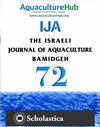The evaluation of ammonia tolerance in introduced and local Pacific white shrimp, Litopenaeus vannamei, populations in China
IF 0.5
4区 农林科学
Q4 FISHERIES
引用次数: 0
Abstract
The white shrimp, Litopenaeus vannamei, is one of the most valuable commodities in the global seafood trade. Affected by high-density farming environments, ammonia accumulates in shrimp cultures and has a strong toxic effect, resulting in poor shrimp survival and poor immune function and metabolism. We selected six different populations of L. vannamei from Xing Hai No.1 (A and B), CHAI, Sy Aqua, PRIMO, and a second-generation Sy Aqua-PRIMO hybrid population (SP). The shrimps (3.24 ± 0.71 cm body length) were exposed to ammonia (24 h, 48 h), followed by recovery (R48 h, R96 h) to assess the tolerance of different populations. The survival rate (SR), immune-related enzymes (superoxide dismutase SOD, catalase CAT, and Glutathione peroxidase GSH-PX), Malondialdehyde (MDA), and metabolism (glutamate dehydrogenase GDH, glutamine synthetase GS, and aspartic acid transaminase GOT) and were measured at different populations under acute ammonia stress. Multiple comparisons of the ammonia resistance index from six populations showed that the expression of these indicators varied among the populations. The degree of lipid peroxidation in the Sy Aqua and PRIMO was significantly higher than in the other populations (P < 0.05), and the ammonia metabolism index was poor. The GDH and GOT genes for the Xing Hai No.1 (A) were higher than for the other populations. Mortality and physiological indicators recovered to varying degrees for all experimental populations following 96 h of ammonia relief, whereas the Sy Aqua and PRIMO showed a noticeable lag. These results indicated that the immunity and metabolic capacity of Xing Hai No.1 (A) might be higher than those of Sy Aqua and PRIMO. These data could have value in developing future scientific breeding schemes and in the sustainability of shrimp farming.中国引进和本地凡纳滨对虾(Litopenaeus vannamei)种群的氨耐受性评价
凡纳滨对虾(Litopenaeus vannamei)是全球海产品贸易中最有价值的商品之一。受高密度养殖环境的影响,氨在对虾养殖中积累,具有很强的毒性作用,导致对虾成活率差,免疫功能和新陈代谢差。从星海1号(A和B)、柴、赛水、PRIMO和赛水-PRIMO二代杂交群体(SP)中选取了6个不同群体。将体长为3.24±0.71 cm的对虾分别处理24 h、48 h,恢复时间分别为R48 h、R96 h,以评价不同种群对氨的耐受性。测定急性氨胁迫下不同种群的存活率(SR)、免疫相关酶(超氧化物歧化酶SOD、过氧化氢酶CAT和谷胱甘肽过氧化物酶GSH-PX)、丙二醛(MDA)和代谢(谷氨酸脱氢酶GDH、谷氨酰胺合成酶GS和天冬氨酸转氨酶GOT)。对6个种群抗氨指数的多次比较表明,这些指标的表达在不同种群之间存在差异。Sy Aqua和PRIMO的脂质过氧化程度显著高于其他群体(P < 0.05),氨代谢指数较差。星海1号(A)的GDH和GOT基因均高于其他群体。在氨水缓解96 h后,所有实验群体的死亡率和生理指标均有不同程度的恢复,而Sy Aqua和PRIMO表现出明显的滞后性。上述结果表明,星海1号(A)的免疫和代谢能力可能高于赛水(Sy Aqua)和PRIMO。这些数据可能对制定未来的科学育种计划和对虾养殖的可持续性有价值。
本文章由计算机程序翻译,如有差异,请以英文原文为准。
求助全文
约1分钟内获得全文
求助全文
来源期刊
CiteScore
0.90
自引率
16.70%
发文量
49
审稿时长
3 months
期刊介绍:
Information not localized

 求助内容:
求助内容: 应助结果提醒方式:
应助结果提醒方式:


